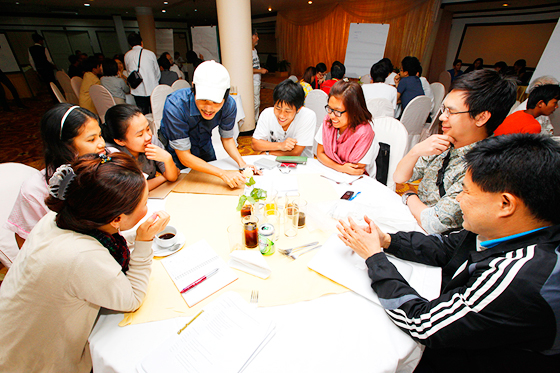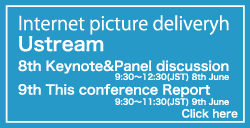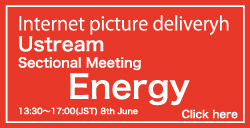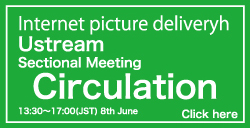��8��T�X�e�i�u���f�U�C�����ۉ�c�́A�������l�������܂��āA�����ɉ�I���������܂����B����8�������J��ڏ��ɐ���������߂Ă���܂��B���܂��炭���҂����������B�Ȃ��A������̗l�q�͐����AFacebook�y�[�W��������Ustream�y�[�W�ɃA�b�v���Ă���܂����̂ŁA����������Ђ����������B
The 8th International Conference of Design for Sustainability has come to an end after a smooth and successful three days. The reports of the conference are being produced and will be available for the general public in August. We appreciate your patience. In the meantime, you can also find video footage of the conference sessions on our Ustream page that can be viewed at any time.
About the Conference �@-�k��B�s�ł̍��ۉ�c�J�Âɂ���-

�k��B�s�ŊJ�Â����8��T�X�e�i�u���f�U�C�����ۉ�c�́A�A�W�A�̊F�Ŏ��B�̖������l���A�l����z�����V�F�A���܂��傤�I
�T�X�e�i�r���e�B���l���čs����ŁA�k��B����{�̓s�s�ōs���Ă��鎝���\�Ȏ�g�݂����łȂ��A�A�W�A��n���ōs���Ă��鎝���\�Ȏ�g�݂��A�R�~���j�e�B����̂Â���Ȃǐ����ɐg�߂ȃe�[�}�⎖������ƂɁA��r���A���ʓ_��T��A���������l����T�X�e�i�r���e�B�ɂ��čl����[�߂Ă��������ƍl���Ă��܂��B
�������̕�炵�ɖ��ڂɊւ��e�[�}����ɂ���2�̃T�X�e�i�r���e�B���ۑ�⋤�ʓ_��T��A���ꂩ��̖������f�U�C�����܂��B�����Ő��܂ꂽ���ʂ���{�����łȂ��A�A�W�A�����ăV�F�A���Ă����܂��B
Let’s share ideas and thoughts about the sustainable future in Asia on this conference to be held in Kitakyushu city, Japan!!
In considering sustainability, learning sustainable efforts in Asia and local communities are very important as well as in the city of Japan and Kitakyushu.
The 8th International Conference of Design for Sustainability will provide a valuable opportunity for the participants to find the common challenges and hints for solutions through exchanging ideas and learning from each other. The results of this international conference will be shared among Japanese and people in wider Asia for designing the sustainable Asian Future.

Characteristics �@-�{��c�̓����[-
LANGUAGE
���ʌ���@�p��
Common Language : English
���u����v���[���e�[�V�������p��ōs���܂��B�����ʖ�A�����ʖ����܂����A�p��ł̃f�B�X�J�b�V�����ɒ��킵�Ă��������B
This conference will conduct lectures and presentations in English.
Though simultaneous interpretation and consecutive interpretation to be prepared, please try to discuss in English.
MEDIA
�C���^�[�l�b�g�f���z�M
Internet picture deliveryh
�J���t�@�����X�T�A�U�̓C���^�[�l�b�g��Ő��E�։f���z�M����\��ł��B
Live video of conference �T, �U are going to be delivered over the Internet to the world.
Summary �@-�T�v-
| ������ | ��8��T�X�e�i�u���f�U�C�����ۉ�c |
|
| ����� | �G�N�X�J�[�V���� | �@2013�N6�� 7���i���j |
| �J���t�@�����X�T | �@2013�N6�� 8���i�y�j | |
| �J���t�@�����X�U | �@2013�N6�� 9���i���j | |
| ����� | �k��B�C�m�x�[�V�����M�������[�A�k��B�s���~���[�W�A���A ��B�q���[�}�����f�B�A�n���Z���^�[�A�k��B�s�������擌�c�n��A����ю��� |
|
| ���Q���� | ���ڎQ����100���@�܂��C���^�[�l�b�g�z�M�ɂ��Q�� | |
| ����� | �T�X�e�i�u���f�U�C�����ۉ�c���s�ψ���@ �k��B�T�X�e�i�u���f�U�C�����ۉ�c���s�ψ��� |
|
| ������ | �k��B�s�A���v���c�@�l�^�J�~���E�}���o�[���ی���c | |
| ���㉇ | �Ɨ��s���@�l���ۋ��͋@�\ ���v���c�@�l��B�q���[�}�����f�B�A�n���Z���^�[ | |
| �����^ | ������А��������@TOTO��������@�������LIXIL�@������В}�����ۑS�Z���^�[�@�������ATGREEN�@������Б���c���������@������АV�H�@������Ѓ����N | |
| �������� | NPO�@�l���R���l����� | |
| ��Title | The 8th International Conference of Design for Sustainability 7th,8th,9th on June, 2013 |
| ��Dates | 7th Excursions�@8th Conference�T 9th Conference�U |
| ��Venue | Kitakyushu Innovation Gallery and Studio, Kitakyushu Environment Museum, Human media Creation Center/KYUSHU and in the City of Kitakyushu |
| ��Participants | About 100 peoples |
| ��Organizer | Executive committee of international conference of design for sustainability. Executive committee of international conference of design for sustainability in Kitakyushu. |
| ��Co-Organizer | City of Kitakyushu, Takamiya Mariver Foundation for Environmental Protection |
| ��Supports | Japan International Cooperation Agency, Human media Creation Center/KYUSHU |
| ��Sponsors | Nishihara Corporation,�@TOTO LTD.,�@LIXIL Corporetion, Chikushi Environmental Conservation Center, ATGREEN Co., Ltd.�@Waseda Environmental Institute Co., Ltd. Shinryo Corporation,�@Linc Co,.ltd. |
On the event of the 8th International Conference of Design for Sustainability �@
-�J�Âɂ�������-
�l�Ԃ͌Ñ���A���E�e�n�ŗl�X�ȕ�����z���グ�Ă͕������邱�Ƃ��J��Ԃ��Ă��܂����B����N�ɂ��y�Ԃ����������s����̉ʂĂɂ��ǂ�������㕶���́A70���l���z����l�X���ׂĂ���̑̌n�̒��Ɏ�荞�ނƂ����Ӗ��ŁA����ȑO�̕����Ƃ͋K�͓I�ɂ����I�ɂ��قȂ���̂ł���Ƃ����܂��B
�������A���̌��㕶���́A��������200�N�]��ł��łɗl�X�Ȗ����ɓ˂�������A�n���������͂��ߑ����̂ق���т���������܂��B���̂܂܂ł́A����҂����ɍs���l�܂�A�Z���ȕ����̈�Ƃ��ďI�����}���邱�ƂɂȂ肩�˂܂���B
�����Ȃ�Ȃ����߂ɑłׂ����łƂ��ƁA��������1990�N�㏉�߂�������ׂ̏��Ȃ����̂Â���Ɏ��g��ł��܂����B�������A�Z�p�I�Ȗ��������������ĐV���ȏ���g��������ȂǁA�Z�p�C�m�x�[�V�������K�������T�X�e�i�u���ȎЉ�Â���ɒ������Ȃ����Ƃ������Ă��܂����B
����͓����ɁA�l�X�̐��E�ς≿�l�ς̌��������܂ގЉ�C�m�x�[�V�����̉\����Nj����邽�߂ɃT�X�e�i�u���f�U�C�����ۉ�c�𗧂��グ��_�@�Ƃ��Ȃ�A2006�N�ɑ�P��̍��ۉ�c�ł���”Destination 2006-2026”���J�Â��܂����B
����ȍ~�A�T�X�e�i�u���f�U�C���̗̈�����ɂ߂���P��A���n�_�Ƃ��ẴT�X�e�i�u���ȎЉ�r�W������`������Q��A�s�����N�������ӂ���R��A��i�I�ȎЉ�ϊv�r�W�l�X��m������S��A�n��ŗL�̎Љ�r�W�l�X���R�`���ŒT������T��Ƒ����܂����B
2011�N2�����ɓ��k�n���ŊJ�Â�����5��̍��ۉ�c��2�T�Ԍ�ɋN���������{��k�Ђƕ�����ꌴ�q�͔��d���̎��̂ɂ���āA���{�̎Љ�V�X�e���������ɃT�X�e�i�u���ł͂Ȃ��iun-sustainable�j���̂ł��邩�A�Ƃ������Ƃ��I�悵�܂����B����ɂ���āA���̉�c���������ׂ�������������I�Ȃ��̂ɂȂ�܂����B
����́A�����A�G�l���M�[�A�H���̂ǂ���Ƃ��Ă����O�ł܂��Ȃ����Ƃ��ł��Ȃ����{���A�܂��̓A�W�A�̈���Ƃ��ē���A�W�A���͂��߂Ƃ���ߗ����ƈꏏ�ɐ����čs�����@��͍�����Ƃ������Ƃł��B���̂��߂ɂ́A�܂���X�̎Љ�̎d�g�݂����P���y�₩�ɓ�����悤�ɂ���K�v������܂��B
�����ŁA��6��̃e�[�}��Asian Sustainability�Ƃ��A��7���c�̓o���R�N��Rangsit University�Ƌ��Ƀ^�C�ŊJ�Â��܂����B�����E�G�l���M�[�̑�ʏ���ł��葱���郈�[���b�p���̃T�X�e�i�r���e�B�Ƃ͈قȂ�A��葽�l���Ə_��ɕx���resilient�ȃA�W�A�^�T�X�e�i�u���Љ�̉\�����A�W�A�̐l�X�ƂƂ��ɍl���čs�����Ƃ������݂ł��B
���̓x�A�k��B�s�Ƃ�����i�I�ȓs�s�G�l���M�[�C���t���Z�p���������n��ő�8���c���s���ɓ������āA����������i�Z�p�ƃA�W�A�^�T�X�e�i�r���e�B�̉��l�ςƂ̊Ԃłǂ̂悤�ɐ܂荇�������čs���̂��c�_���Ă݂����Ǝv���Ă��܂��B
������ɂ��Ă��A�T�X�e�i�r���e�B�̖ڕW�͖����ł��B����́A������Ȃ��n�����A70���l���z����l�X�łǂ̂悤�ɃV�F�A���Ă䂭���Ƃ������ƂȂ̂ł��B���̂��߂ɂ́A�Ⴆ�Γ��{�l�̉��l�ς��炵���͂��̍��̎���ɍ��킹�č��{���猩�����K�v������̂ł��B
��8��T�X�e�i�u���f�U�C�����ۉ�c ” Destination 2013-2019”�@���s�ψ����@�v�c���a
On the event of the 8th International Conference of Design for Sustainability
Since the dawn of time, human civilisations have risen and fallen in every part of the world. Modern civilisation is the final result of much trial and error carried out over several thousand years. Incorporating over 7 billion people in a single system, it can be said to differ from previous civilisations in terms of both scale and quality.
However, this modern civilisation has encountered various contradictions in the little over 200 years of its existence and is already showing signs of coming apart, as illustrated by global environmental issues. At this rate, modern civilisation could soon reach a deadlock and face demise as one of the more short-lived civilisations of human history.
With the aim of avoiding this, we have been engaging in low-environmental-impact manufacturing since the beginning of the 1990s. However, it has become evident that technological innovation does not necessarily lead directly to the building of a sustainable society. Conversely, technical problem-solving can lead to new increases in consumption, for example.
This trend formed the opportunity to launch the International Conference of Design for Sustainability in order to pursue the possibilities of social innovation, including the review of the worldviews and values of the people. The result was Destination 2006-2026, the first International Conference held in 2006.
This first conference delved into the domain of sustainable design. It was followed by a second conference, which laid out a vision for a sustainable society, and a third, at which agreements for starting actions were reached. The fourth such conference studied leading social innovation businesses and the fifth explored regional social businesses in Yamagata Prefecture.
Then, just two weeks after the fifth International Conference held in the Tohoku region at the end of February 2011, the Great East Japan Earthquake and the Fukushima Daiichi nuclear plant accident occurred. These events exposed just how unsustainable Japan's social system has become. As a result, the direction in which these conferences should proceed was determined; namely, to explore methods by which Japan, heavily dependent on imports of resources, energy and food, can coexist with East Asian and other neighbouring countries.
To achieve this, it is first necessary to show how we can eliminate excesses and make the system more agile.
Accordingly, the theme of Asian Sustainability was adopted from the sixth conference onwards, and the seventh conference was jointly held in Thailand with Rangsit University, situated in Bangkok. This was an attempt to consider the possibility of an Asian-style of sustainable society that is resilient, rich in diversity and highly flexible, and differing from European sustainability, whereby countries can continue to consume large quantities of resources and energy.
Now, on the occasion of the eighth conference in Kitakyushu City, which is furnished with advanced urban energy infrastructure technologies, we hope to discuss how to reach a balance between such advanced technologies and the value system of Asian-style sustainability.
In any case, the objective of sustainability is clear: To find a way for over 7 billion people to share this one and only planet Earth. And for this it is necessary to re-examine, for example, the values and way of living of the Japanese people from their very foundation in accordance with the realities of the country.
Fumikazu Masuda, Executive Committee Chair of “Destination 2013-2019,” The 8th International Conference of Design for Sustainability





